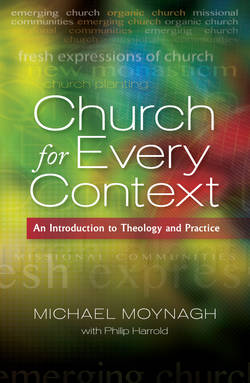Читать книгу Church for Every Context - Michael Moynagh - Страница 105
На сайте Литреса книга снята с продажи.
Questions for discussion
ОглавлениеHow far should the church adapt to changes in society and how far should it seek to be distinct from society?
Can it be said that the expressive self is a Christian self minus God? Or is prioritizing the search for fulfilment fundamentally flawed?
How would you theologically evaluate the network society?
1 Evenness of size is important because it affects the amount of competition. To take an extreme example, if 80 per cent of a suburb were Mormon and they had only one place of worship, while the remaining 20 per cent had three alternatives, the amount of choice for the 80 per cent would be less than if there were several Mormon churches.
2 In his well-received report to Britain’s Methodist Conference in 2011, General Secretary Martyn Atkins spoke candidly of Methodism having too many chapels, an up-to-date echo of Gill’s theme.
3 The ‘Workpaper’ recognized that this argument made all sorts of assumptions and that practice would be more nuanced. But using Church of England figures (and proxies) available for annual gains and losses, the number of parishes, the size of churches and the number of clergy, the model predicted that the average congregation would stabilize at around 150, which was a little lower than the national average for a single clergy congregation (Urban Church Project, 1974, p. 11).
4 Yoder’s comment is echoed in John Hull’s opposite criticism of Mission-shaped Church, ‘We looked for a mission-shaped church but what we found was a church-shaped mission.’ (Hull, 2006, p. 36) I am grateful to John Flett for drawing my attention to the Yoder quote.
5 For a brief introduction to the idea of post-secularity, see Graham Ward (2009, pp. 117–58).
6 ‘Minipreneurs’, www.trendwatching.com (accessed 22 February 2011).
7 Post-Fordism is accessibly introduced by Kumar (1995, pp. 36–65).
8 To do this it will have to engage carefully with the critiques of media technology, such as those provided Sherry Turkle (1995, 2011), though she may overstate her case.
9 The range of views is well summarized by Bretherton (2010, pp. 6–10). Percy quotes Putnam (Percy, 2010, p. 73) but not sociologists like Anthony Giddens and Manuel Castells who are more hopeful.
10 A Microsoft survey of over 1,000 British people found that each person’s average number of friends increased by an astonishing 64 per cent between 2003 and 2006; nearly a third of the sample had made friends online. (‘Britons Make More Time for Friendship than Ever Before’, November 2006, www.microsoft.com.) McPherson, Smith-Lovin and Brashears (2006) found that the mean number of people with whom adult Americans could discuss matters important to them had dropped by nearly a third between 1985 and 2004.
11 Danah Boyd, ‘Friends, Friendsters, and Top 8: Writing community into being on social network sites’, First Monday, December 2006, www.firstmonday.org.
